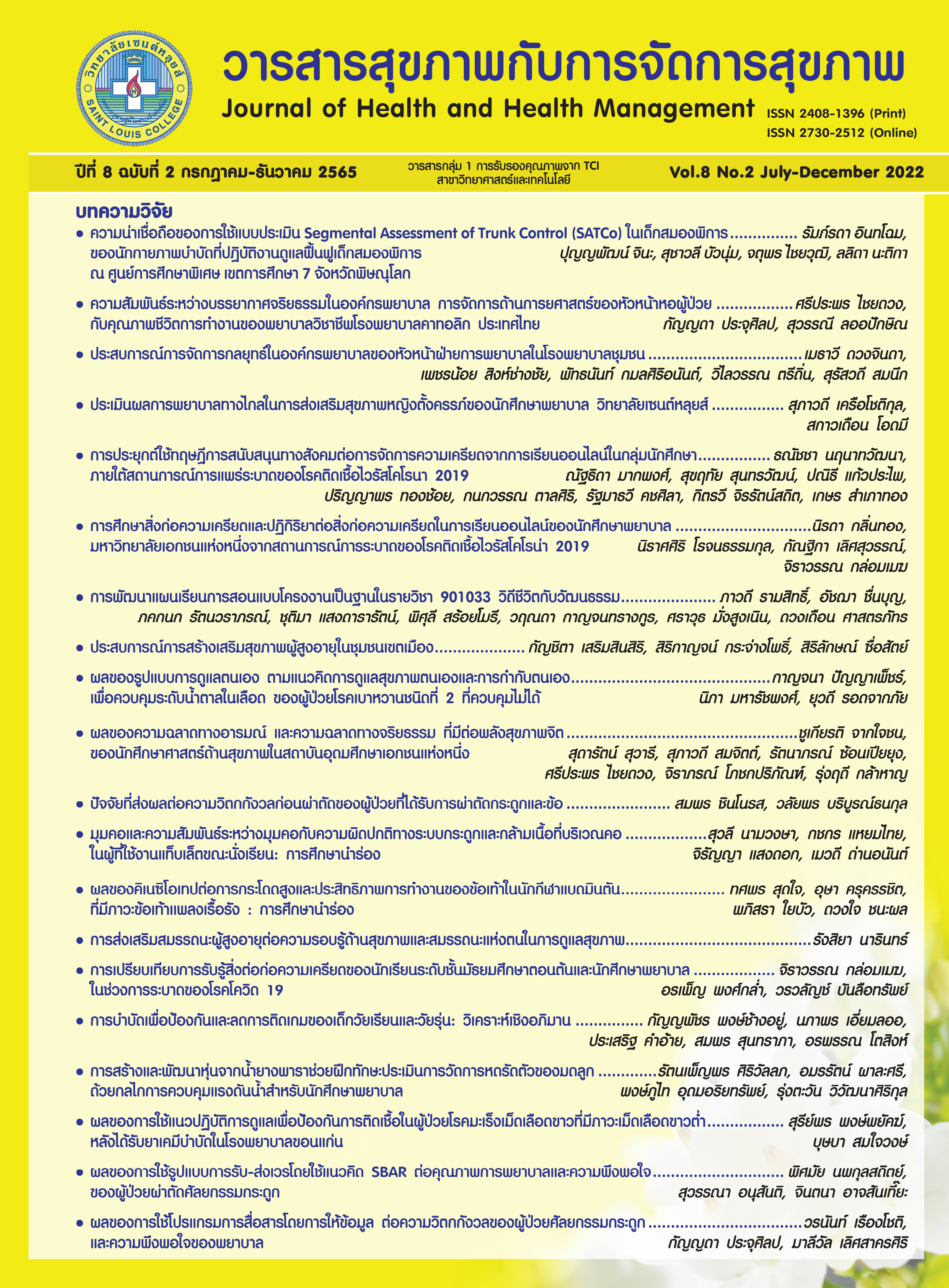ผลของคิเนซิโอเทปต่อการกระโดดสูงและประสิทธิภาพการทำงานของข้อเท้าในนักกีฬาแบดมินตันที่มีภาวะข้อเท้าเเพลงเรื้อรัง : การศึกษานำร่อง
คำสำคัญ:
ข้อเท้าแพลง, คิเนซิโอเทป, กระโดดสูง, กระโดดในทิศทางรูปหกเหลี่ยมกระโดดไปด้านข้างบทคัดย่อ
ข้อเท้าเเพลงเป็นการบาดเจ็บที่พบบ่อยในนักแบดมินตัน เท้าไม่อยู่ในแนวปกติทำให้เพิ่มความเสี่ยงต่อการเกิดข้อเท้าเเพลง ข้อเท้าเเพลงเรื้อรังสามารถทำให้เกิดภาวะความไม่มั่นคงของข้อเท้า ส่งผลให้ความสูงของการกระโดดและประสิทธิภาพการทำงานของข้อเท้าลดลง การใช้คิเนซิโอเทปเทคนิคการควบคุมเชิงกลศาสตร์ช่วยกระตุ้นให้ท่าทางอยู่ในแนวปกติและเพิ่มการรับรู้ข้อต่อ วัตถุประสงค์ของการศึกษาเป็นการเปรียบเทียบผลทันทีของการใช้คิเนซิโอเทประหว่างแบบให้แรงดึงและไม่ให้แรงดึงต่อการกระโดดสูงและประสิทธิภาพการทำงานของข้อเท้าในนักกีฬาแบดมินตันที่มีภาวะข้อเท้าเเพลงเรื้อรัง การศึกษานี้เป็นการศึกษาเชิงทดลองแบบไขว้ นักกีฬาแบดมินตันเพศชายและหญิง จำนวน 12 คน อายุ 18 – 30 ปี (อายุเฉลี่ย 20.41 ±2.31 ปี) ที่มีภาวะข้อเท้าแพลงและเท้าไม่อยู่ในแนวปกติ อาสาสมัครทุกคนถูกสุ่มให้ใช้คิเนซิโอเทปเทคนิคการควบคุมเชิงกลศาสตร์แบบให้แรงดึงและไม่ให้แรงดึง และได้รับการประเมินด้วยการกระโดดสูง การกระโดดในทิศทางรูปหกเหลี่ยมและกระโดดไปด้านข้างในช่วงก่อนและหลังการใช้คิเนซิโอเทป 30 นาทีโดยผู้วัดที่ถูกปกปิด อาสาสมัครทุกคนทำการพัก 7 วัน และทำการทดสอบเช่นเดิม แต่เปลี่ยนการใช้คิเนซิโอเทปเป็นอีกเทคนิค การวิเคราะห์ข้อมูลทางสถิติเพื่อเปรียบเทียบของค่าเฉลี่ยระหว่างกลุ่มใช้ dependent Samples T-Test การกระโดดในทิศทางรูปหกเหลี่ยม (p = 0.039) และกระโดดไปด้านข้าง (p = 0.020) พบว่ามีความแตกต่างอย่างมีนัยสำคัญทางสถิติระหว่างการใช้คิเนซิโอเทปแบบไม่ให้แรงดึงและให้แรงดึง อย่างไรก็ตามไม่พบความแตกต่างอย่างมีนัยสำคัญทางสถิติของความสูงของการกระโดดระหว่างการใช้คิเนซิโอเทปแบบไม่ให้แรงดึงและให้แรงดึง (p = 0.103) ผลทันทีของการใช้คิเนซิโอเทปเทคนิคการควบคุมเชิงกลศาสตร์แบบให้แรงดึงสามารถช่วยส่งเสริมประสิทธิภาพการทำงานของข้อเท้าในภาวะข้อเท้าแพลงเรื้อรัง
References
ธีรศักดิ์ บุญวัง, ปวีณ วิยาภรณ์, ภานุพงศ์ ภัทรเชาว์, วรเชษฐ์ จันติยะ, และพิชชาภา คนธสิงห์. (2563). ผลฉับพลันของการติดเทปกาวผ้ายืดติดผิวหนังต่อสมรรถนะการกระโดด ในนักกีฬาชายระดับมหาวิทยาลัย. วารสารมหาวิทยาลัยคริสเตียน, 26(2), 61-71.
Bicici, S., Karatas, N., & Baltaci, G. (2012). Effect of athletic taping and kinesiotaping® on measurements of functional performance in basketball players with chronic inversion ankle sprains. International journal of sports physical therapy, 7(2), 154-166.
Biz, C., Nicoletti, P., Tomasin, M., Bragazzi, N. L., Di Rubbo, G., & Ruggieri, P. (2022). Is Kinesio Taping Effective for Sport Performance and Ankle Function of Athletes with Chronic Ankle Instability (CAI)? A Systematic Review and Meta-Analysis. Medicina, 58(5), 620 https://doi.org/10.3390/medicina58050620
Doherty, C., Delahunt, E., Caulfield, B., Hertel, J., Ryan, J., & Bleakley, C. (2014). The incidence and prevalence of ankle sprain injury: a systematic review and meta-analysis of prospective epidemiological studies. Sports medicine, 44(1), 123-140.
Ferreira, R., Resende, R., & Roriz, P. (2017). The effects of Kinesio Taping® in lower limb musculoskeletal disorders: a systematic review. International Journal of Therapies and Rehabilitation Research, 6(3), 1-13
Jafari, A., Mabani, M., & Golami, M. (2014). The prevalence and causes of sport injuries in well-trained badminton players of Iran. International Journal of Basic Sciences and Applied Research, 3(1), 40-44.
Jeanfavre, M., Humphrey., A. & Klein, M. (2021). A Systematic Review of Return to Sport Physical Performance Tests of the Foot and Ankle. CPQ Orthopaedics, 5(3), 01-105.
Kim, M. K., & Shin, Y. J. (2017). Immediate effects of ankle balance taping with kinesiology tape for amateur soccer players with lateral ankle sprain: a randomized cross-over design. Medical science monitor: international medical journal of experimental and clinical research, 23, 5534-5541.
Luque-Suarez, A., Gijon-Nogueron, G., Baron-Lopez, F. J., Labajos-Manzanares, M. T., Hush, J., & Hancock, M. J. (2014). Effects of kinesiotaping on foot posture in participants with pronated foot: a quasi-randomised, double-blind study. Physiotherapy, 100(1), 36-40.
Nunes, G. S., Feldkircher, J. M., Tessarin, B. M., Bender, P. U., da Luz, C. M., & de Noronha, M. (2021). Kinesio taping does not improve ankle functional or performance in people with or without ankle injuries: Systematic review and meta-analysis. Clinical Rehabilitation, 35(2), 182-199.
Padasala, M., Bhatt, J.H., D’Onofrio., R. (2019). Effects of kinesio taping on functional performance test with chronic ankle instability in collegiate basketball player. Italian Journal of Sports Rehabilitation and Posturology, 6(1), 1112 -1150.
Reneker, J. C., Latham, L., McGlawn, R., & Reneker, M. R. (2018). Effectiveness of kinesiology tape on sports performance abilities in athletes: A systematic review. Physical Therapy in Sport, 31, 83-98.
Sarvestan, J., Alaei, F., Kazemi, N. S., Khial, H. P., Shirzad, E., & Svoboda, Z. (2018). Agility profile in collegiate athletes with chronic ankle sprain: the effect of Athletic and Kinesio taping among both genders. Sport Sciences for Health, 14(2), 407-414.
Sarvestan, J., Ataabadi, P. A., Svoboda, Z., Kovačikova, Z., & Needle, A. R. (2020). The effect of ankle Kinesio™ taping on ankle joint biomechanics during unilateral balance status among collegiate athletes with chronic ankle sprain. Physical Therapy in Sport, 45, 161-167.
Tomruk, M. S., Tomruk, M., Alkan, E., & Gelecek, N. (2022). Is Ankle Kinesio Taping Effective to Immediately Change Balance, Range of Motion, and Muscle Strength in Healthy Individuals? A Randomized, Sham-Controlled Trial. Korean Journal of Family Medicine, 43(2), 109-116.
Tsai, L. C., Yu, B., Mercer, V. S., & Gross, M. T. (2006). Comparison of different structural foot types for measures of standing postural control. Journal of Orthopaedic & Sports Physical Therapy, 36(12), 942-953.
Wang, Y., Gu, Y., Chen, J., Luo, W., He, W., Han, Z., & Tian, J. (2018). Kinesio taping is superior to other taping methods in ankle functional performance improvement: a systematic review and meta-analysis. Clinical rehabilitation, 32(11), 1472-1481.
Wilson, B., & Bialocerkowski, A. (2015). The effects of Kinesiotape applied to the lateral aspect of the ankle: relevance to ankle sprains–a systematic review. PLoS One, 10(6), e0124214.
Wilson, V., Douris, P., Fukuroku, T., Kuzniewski, M., Dias, J., & Figueiredo, P. (2016). The immediate and long-term effects of kinesiotape® on balance and functional performance. International journal of sports physical therapy, 11(2), 247-253.
Yam, M. L., Yang, Z., Zee, B. C. Y., & Chong, K. C. (2019). Effects of Kinesio tape on lower limb muscle strength, hop test, and vertical jump performances: a meta-analysis. BMC musculoskeletal disorders, 20(1), 1-12.
Downloads
เผยแพร่แล้ว
How to Cite
ฉบับ
บท
License
Copyright (c) 2022 วารสารสุขภาพกับการจัดการสุขภาพ

This work is licensed under a Creative Commons Attribution-NonCommercial-NoDerivatives 4.0 International License.



